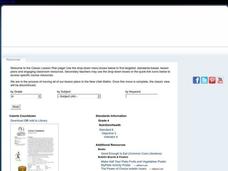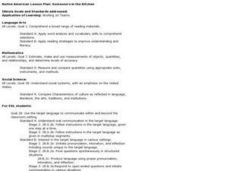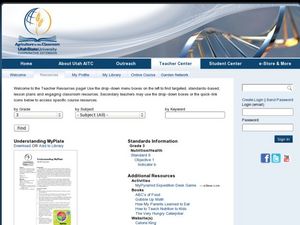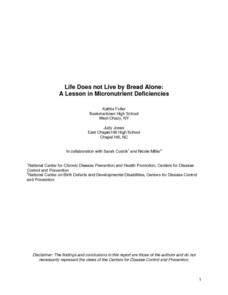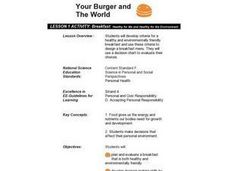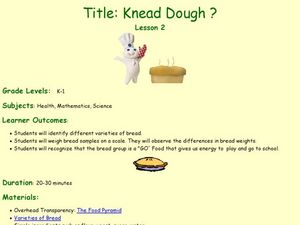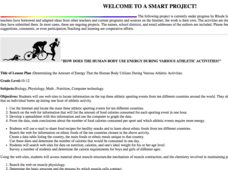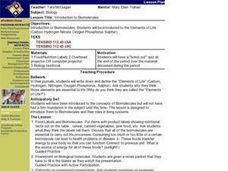Curated OER
Calorie Countdown
Fourth graders explore human health by identifying calories in food items. In this healthy eating habits lesson, 4th graders view the USDA food pyramid on the Internet and identify the choices they should be making each day. Students...
Curated OER
Little Red Hen
First graders explore biology by identifying plant anatomy in class. In this botany lesson, 1st graders read the book The Little Red Hen and identify the methods used in order to grow successful plants. Students discuss other ways people...
Curated OER
Abbreviations, Substitutions, Equivalents Review Lab
Students work together to prepare a cookie recipe. In groups, they measure ingredients and review abbreviations and substitutions when it comes to different systems of measurement. To end the lesson, they demonstrate the use of the...
Curated OER
Exploding Cheeseburger
Second graders describe the components of a healthy diet. In this nutrition and health lesson, 2nd graders identify the importance in eating a variety of healthy food. Students explain what makes a healthy diet.
Curated OER
Vary Your Veggies and Focus on Fruits
Third graders study a healthy diet. For this healthy diet lesson, 3rd graders investigate the nutritional value of fruits and vegetables. Students compare a healthy diet to their personal diet.
Curated OER
More Than One Grain of Rice
Sixth graders explore cultural habits by viewing food videos in class. In this agriculture lesson, 6th graders identify the importance of rice in the human diet and how different cultures prepare the food. Students view rice harvesting...
Curated OER
Native American Lesson Plan: Someone's in the Kitchen
Students use vocabulary necessary to complete cooking activities and tell others about the food. They discuss similarities and differences between Native American and other nationalities' foods made in their families.
Curated OER
Healthy Diet
Third graders recognize what constitutes a healthy diet and explore if their diet is healthy. In this healthy diet instructional activity, 3rd graders listen read books and explore the food pyramid to find a balanced diet. Students...
Curated OER
Life Does Not Live By Bread Alone
High schoolers investigate the relationship between micronutrients and proper metabolic function. The lesson plan should serve as an introduction to the subject. The subject of the function includes the study of plants, animals, and...
Curated OER
What's On Your Plate?
Students explore the use of sensory details in writing. In this journal writing lesson, students write four journal entries after group discussion about a variety of topics such as their weekend, poverty in the United States, and...
Curated OER
Breakfast: Healthy for Me and Healthy for the Environment
Students develop criteria for a healthy and environmentally friendly breakfast and use these criteria to design a breakfast menu. They use a decision chart to evaluate their choices which is imbedded in this plan.
Curated OER
Energy Balance: The Ins and Outs
Pupils review data from a 24-hour dietary recall to gain an understanding of the information regarding energy intake and macronutrients.
Curated OER
Staying Healthy Year Round
Young scholars will read literature about the seasons and observe and describe the weather in each. The group will compare and contrast the activities of people during different weather conditions showing how they adapt to changes. They...
Curated OER
Claire Damarodas
Fifth graders examine how sugars may be listed as an ingredient in various ways. E.g. Many of the words end in -ose (ex. Sucrose, dextrose, maltose)
Curated OER
Comparing Microscopic Organisms in Fresh and Polluted Water: An Invitation To Inquiry
Young scholars have the opportunity to develop and formulate ideas and explanations through the scientific standard of inquiry. They identify organisms by using an identification key for specific aquatic geographical area.
Curated OER
WHERE'S THE BEEF?
The student will become visually aware of the different shapes of wholesale cuts of beef.1. Ask a local meat cutter to make a class visit to explain his or her job. 2. Enlarge the steer outline on Student Worksheet B, and place it on a...
Curated OER
One Kid Can Make A Difference
Students make a pledge to make three positive choices for 30 days and track their progress. In this positive choices lesson plan, students discuss ways in which they can be healthier, protect the environment, be respectful, and more....
Curated OER
Knead Dough?
Learners make bread and understand that bread gives us energy. For this bread lesson plan, students read the story A Trip to the Market, and learn about the importance of bread. Then they make the bread!
Curated OER
Name That Cheese!
Students explore a variety of cheese. In this cheese lesson, students sample 4 different cheeses produced from cow's milk and recorded their observations about the cheeses prior to identifying them.
Curated OER
Fish Activities
For this fish activity worksheet, students learn a counting rhyme about fish. They then discuss the best way to care for fish and they learn 4 different types of fish. On the second page, students count lines of fish and color them a...
Curated OER
Mystery "F & V's"
Fourth graders explore agriculture by reading assigned text about produce. In this fruits and vegetables lesson, 4th graders identify the healthy benefits of consuming fresh produce and what minerals and vitamins they contain. Students...
Curated OER
Microorganism Multiplication
Sixth graders explore biology by viewing video clips in class. For this microorganism identification lesson, 6th graders identify the types of organisms that can feed small animals such as algae and protozoans. Students view video clips...
University of Rhode Island
How Does the Human Body Use Energy during Various Athletic Activities?
Students investigate how much energy is used during different athletic activities. They conduct Internet research to obtain information on the top three athletic sporting events from around the world, and calculate the calories burned...
Curated OER
Introduction to Biomolecules
Young scholars are introduced to biomolecules and their roles in livin systems. They are introduced to the "Elements of Life." Students write down and define the "Elements of Life." They are asked why they think those elements are...


